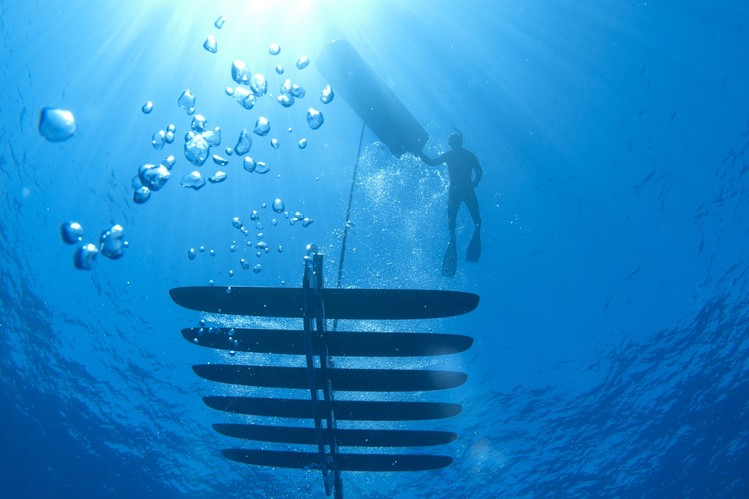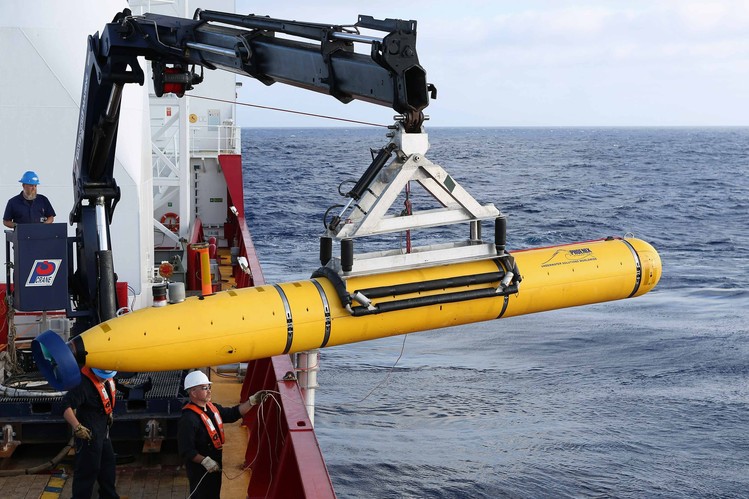Above: U.S. researchers are developing a mobile submarine-surveillance network called Seaweb that uses drones including the Wave Glider, seen here. Photo Credit: LIQUID ROBOTICS
Last November, an unusual experiment took place in the congested waters of Singapore just a few weeks before a Chinese nuclear attack submarine passed through the adjacent Malacca Strait.
U.S. and Singaporean researchers used an underwater drone named Starfish to explore ways to monitor subsea activity in an experiment sponsored by the U.S. military and Singapore’s defense ministry, say people involved.
The goal of the operation, named Project Mission, was to link a Singaporean underwater surveillance system to an American one that is designed to track potentially hostile submarines. The trial was also part of a broader U.S. effort to use its own underwater drones, combined with data from friendly countries, to enhance a sub-snooping system that dates back to the early years of the Cold War.
From the 1950s, the U.S. listened for Soviet subs entering the Atlantic and Pacific oceans by stringing underwater microphones across the seabed around its coast and in strategic chokepoints, such as between the U.K. and Iceland.
These cable-linked “hydrophones” were part of a secret global network called Sound Surveillance System, or Sosus. The U.S. declassified Sosus in 1991, making it available for civilian purposes such as tracking illegal fishing or whales.
But in recent years, the U.S. and its allies have reactivated or upgraded elements of the system in Asia, partly in response to renewed Russian undersea activity, but also to monitor China’s expanding submarine capabilities. “It never went away per se, and so we—if you will—revitalized all the attributes or assets,” says Adm. Jonathan Greenert, the U.S. Chief of Naval Operations.
The U.S. is now attempting to combine those fixed seabed systems, as well as sub-hunting ships and aircraft, with mobile networks of sensors, some mounted on underwater drones that can be deployed by ships, planes or subs, say officers familiar with the plans.
At the same time, those officers say, the U.S. Navy is exploring ways to tap data from sensors used by other countries in the region, especially around chokepoints that Chinese subs must pass to reach the Pacific and Indian Oceans.
“We’re very close with the Australians in this regard, very close with the Japanese in this regard, working to a greater degree with the Koreans in this regard, the Singaporeans,” says Adm. Greenert. “The Malays, the Indonesians, are increasing their interest and willingness.”
The exact location of Sosus hydrophones in Asia remains classified. Researchers and former submariners familiar with the system say there are several arrays around Japan, which played a key role hunting for Soviet subs in the Cold War, and around Australia’s Christmas Island.
The problem with cable-based hydrophones is that they require regular maintenance and shore stations in friendly countries. Fixed seabed hydrophones can only act as a virtual trip wire, signaling that a sub is passing at that moment. They are also most effective in relatively deep water with little congestion.
Recent U.S. efforts have focused on developing mobile undersea surveillance networks for congested and shallow waters like those near China’s coast.
The U.S. Navy has deployed one such network—the Persistent Littoral Undersea Surveillance, or PLUS, system—which uses seabed sensors and unmanned vehicles that relay data via satellite. “We’ve deployed PLUS,” says Adm. Greenert. “We sent it out on a mission—I can’t tell you where—and it was effective.”
He says that PLUS requires further testing but that the Navy is already using some small undersea drones for anti-sub warfare.
The biggest obstacles: Most underwater drones run on batteries that last only a few hours, and communicating with them is tough, given how slowly data passes through water.
Both of those issues were demonstrated when the U.S. Navy deployed an undersea drone called the Bluefin-21 in the search for missing Malaysia Airlines flight MH370.
Above: A U.S. Navy Bluefin-21 underwater drone — similar to those used for sub-hunting — goes into action in the search for missing Malaysia Airlines Flight MH370. Photo Credit: REUTERS
“You can think of underwater telecommunications as being roughly where the Internet was 30 years ago,” says Mandar Chitre, an expert in underwater acoustics at the National University of Singapore who took part in the November experiment.
Singapore has made significant advances in underwater acoustics in recent years, developing a system called UNET that monitors undersea activity off Singapore using a network of seabed sensors, undersea drones and surface nodes that relay data over a mobile-phone network.
Singaporean waters are considered especially challenging because of varying depth, busy shipping and the snapping shrimp—a creature whose distinctive noise has long troubled undersea-warfare specialists.
The experiment in November was to link the Singaporean network to a U.S. system called Seaweb, which is being developed by the Naval Postgraduate School with funding from the Office of Naval Research. “The results were very good,” Prof. Chitre says.
A spokeswoman for Singapore’s Defense Ministry confirmed that it had co-sponsored the experiment on linking UNET to Seaweb, but didn’t respond to questions about its broader purpose or applications to anti-submarine warfare.
Public information about Seaweb shows that it aims to create a new global network of submarine sensors from the U.S., its NATO allies and other friendly countries.
“The idea behind Seaweb,” says Rear Adm. Philip Sawyer, commander of U.S. submarine forces in the Pacific, is “to network various nodes through the undersea environment and be able to tap that data and bring it where you want, whether it’s Singapore or San Diego.”
“To be able to watch and monitor everything, we need a networked system,” he says.
Re-posted from The Wall Street Journal Online – click HERE for original article.







